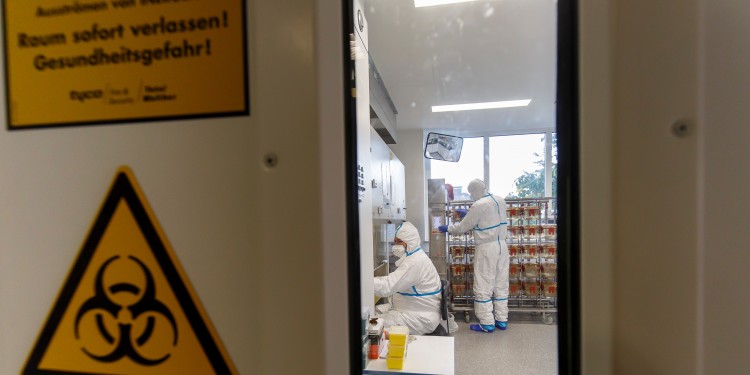
"Don’t worry! We have the viruses under control"
Stephan Ludwig puzzles over a host of questions. There is nothing unusual about that when someone has a passion for science. As a molecular biologist, however, Professor Ludwig is particularly interested in one specific question which is of paramount importance: How do viruses – ‘these tiny little mites’, as he calls them – succeed in remodelling a somatic cell in such a way that they can reproduce inside it, making the host organism sick or even killing it? “We still know very little about the interaction between the pathogen, the cell, and the host organism. Like many of my colleagues, I’m anxious to gain a comprehensive understanding of this problem,” says Stephan Ludwig, who has been teaching and doing research at the University of Münster since 2004.
The solution to Stephan Ludwig’s problem – or at least part of the solution – may be inside an approximately two-metre high silver freezer. You can’t help wincing, and you involuntarily step back 30 centimeters when Stephan Ludwig briefly opens the freezer, which has been cooled down to minus 80 degrees, wafts his hand through the freezing vapour billowing forth from the aperture, and says: “We store highly aggressive viruses in here.” Tiny little mites that can cause diseases such as influenza or bird flu. “But don’t worry,” he adds, “we have the viruses under control.”
A visit to the Center for Molecular Biology of Inflammation confirms this assertion, for the regulations that have to be observed by people who visit Room 120.134 are draconian. There are good reasons for this. Behind the steel door, which is always kept shut, is Münster University’s only security level 3 laboratory. Level 4 is the highest biological protection level. There is a narrow window in the door so that in an emergency situation people outside the lab can see what is going on inside. On one side of the door there is also an intercom beneath a plate bearing the following inscription: “Fire Brigade Bio 3”. By using the intercom people outside of the steel door can talk to staff members who are inside the lab.
For close on 20 years infection experts from the Institutes for Hygiene and Virology have been using this laboratory, which Stephan Ludwig regards as an ‘extremely important piece of equipment’. That is saying a lot, for in other fields, too, scientists make abundant use of state-of-the-art technology such as confocal laser scanning microscopes, total internal reflection microscopes, real-time video microscopes, microinjection studies, FACS analyses, and phospho-imaging. The security level 3 laboratory may only be entered by staff members who have undergone intensive training and are equipped with a special chip card. Every year, they are briefed afresh on how to deal with an emergency. They know how important it is that instructions should be followed to the letter when experiments are conducted with a view to shedding fresh light on issues such as the ability of viruses to reproduce.
Before entering the 25 square metre laboratory, you have to walk through an anteroom into what is known as the airlock. You have to take off your everyday clothes and put on sterile laboratory clothing, which looks like operating theatre clothing – including a surgical cap, a surgical mask, and latex gloves. Now, if not earlier, you will understand what Stephan Ludwig means when, with a twinkle in his eye, he says: “Nodody’s particularly keen to work in here.”
Viewed from inside, the laboratory, which is kept permanently below atmospheric pressure, looks like any other lab. In front of the window there are about twenty confinement cages where mice used for experimental purposes are sometimes kept. Beside the cages there are microbiological safety cabinets. These cabinets, which are typical of scientific laboratories, have a distinctive characteristic: a continuous airflow which serves a protective function. There is a permanent draught which wafts air away from staff members who are using pipettes or similar appliances. “We work with highly infectious strains of wild animals,” says Stephan Ludwig. “And since the risks posed by droplet infection or contact with a pathogen can never be completely eliminated, it’s essential that strict rules should be followed. That’s why I claim that the risk of infection is close to zero.”
One of the strict rules that have to be abided by is that nobody is allowed to work alone in the high-security lab. Another rule is that absolutely nothing should be allowed to leave the room in a way that might constitute a breach of security. In concrete terms, this means, for instance, that staff members fax the results of their measurements from within the laboratory to their colleagues outside the room. They do this in order to avoid having to take paper documents out of the lab. If an object has to be taken out of the lab, it has to pass through a steriliser in which all germs are destroyed by a combination of pressure and steam heated to a temperature of up to 130 degrees. Some people have even thought about a theoretically possible situation where a virus-infected mouse slips away unnoticed and scurries off in the direction of the corridor just as a staff member is leaving the laboratory. Mousetraps have been set in several places. “That,” says Stephan Ludwig, “has also been stipulated by the authorities.”
